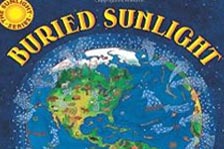
MIT’s Lee and Geraldine Martin Professor of Environmental Studies Penny Chisholm, along with illustrator Molly Bang, have set out to teach elementary students some of the most basic concepts about how life on Earth works. In a new book due to come out October 1st, Buried Sunlight, the pair describe the role of photosynthesis in creating fossil fuels, and how use of this “fossil sunlight” is changing the planet.
The book is part of the “Sunlight Series,” their soon-to-be-completed set of children’s books focused on the sun’s role in the biosphere as the main energy source of life on Earth. The first in the series, My Light, introduces the sun as the narrator and shows how humans change sunlight into electricity. After My Light, Chisholm and Bang describe photosynthesis on land (Living Sunlight) and in the sea (Ocean Sunlight), followed by their newest book Buried Sunlight. Finally, in a book in progress, the two describe the global water cycle and the sun’s role in moving water from land to sea and back again.
Though the Sunlight Series is mainly being marketed towards elementary school students, the authors intend for the books’ colorful illustrations to elucidate their scientific subject matter for adults as well as for children. One of the inspirations for the books was a study showing that many advanced students – including college graduates – didn’t understand that photosynthesis produces living matter from carbon dioxide in the air, making it the foundation of the entire biosphere. The importance of this fundamental concept is what drove Bang and Chisholm to choose the sun as the narrator of the Sunlight books and photosynthesis as the thread uniting them. The authors’ hope their books will not only make a critical scientific concept clear, but will also leave readers in awe for how the Earth functions and help make the information ‘stick.’
This article appears in the Autumn 2014 issue of Energy Futures.